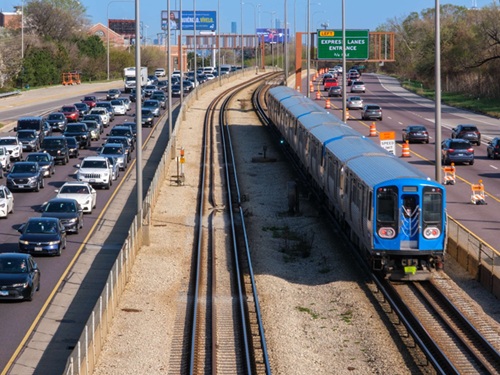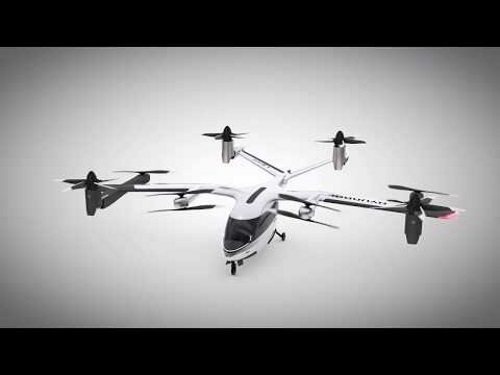New legislation introduced by Senators Alex Padilla, D-Calif., and Jerry Moran, R-Kan., to establish a pilot program to help state, local, and tribal governments prepare for a range of advanced air mobility or AAM operations is getting strong support from state departments of transportation and state aviation officials.
[Above graphic by Hyundai]
Entitled the “Advanced Aviation Infrastructure Modernization” or “AAIM” Act, the bill help would help foster new methods of air travel, including electric vertical take-off and landing of aircraft, to move people and cargo between places previously not served, or underserved, by the traditional aviation industry.

The legislation would create a $25 million grant program for state, local, tribal governments, transit agencies, port authorities, and metropolitan planning organizations to plan the infrastructure needed to support AAM operations.
Subsequently, the Senate Commerce, Science, and Transportation Committee marked up and approved the AAIM Act on May 25.
“As next-generation propulsion aircraft are poised to revolutionize how people and cargo move within and between cities, suburban, and rural areas, advanced air mobility technologies have the potential to transform how we link historically underserved communities,” said Sen. Padilla in a statement. “That’s why I’m excited to introduce this legislation to help states and localities keep pace with this growing sector.”
“American aviation is entering a new era of innovation and growth, and we need to make sure we have the right tools and infrastructure in place to keep pace with these developments,” added Sen. Moran. “Equipping cities with the resources to plan for and utilize this next generation of aircraft will help integrate advanced air mobility operations into existing and future transportation networks.”
[Editor’s note: The Government Accountability Office recently issued a report examining a number of issues the industry and the federal government must address before AAM operations can be widely implemented.]
The American Association of State Highway and Transportation Officials and the National Association of State Aviation Officials both voiced strong support for the AAIM Act as it winds its way forward towards a potential full Senate vote.

“It is critical to have federal, state, local, tribal, and other transportation stakeholders working together on this issue,” said AASHTO Executive Director Jim Tymon in a statement.
“We need to ensure the safe integration of this new technology into our transportation network,” he added. “With the recent House Transportation and Infrastructure Committee passage of companion legislation, our states look forward to this important bill being signed into law.”
[Editor’s note: A bill passed in November 2021 by the House of Representatives seeks to form an “interagency working group” to help further the growth of AAM operations. Called the “Advanced Air Mobility Coordination and Leadership Act” and originally introduced in February sponsored by Rep. Sharice Davids, D-Kan., and Rep. Garret Graves, R-La., the bill tasks the U.S. Department of Transportation with creating this AAM interagency working group.]
“State aviation leaders appreciate this initiative by Senators Padilla and Moran to provide much needed support to state, local and tribal governments as they plan for these emerging aeronautical technologies,” added Greg Pecoraro, NASAO president and CEO. “We are glad that Congress recognizes these resources are critical in assuring that the public interest is met in their safe and accessible integration into the National Aviation System.”
Many state DOTs are already hard at work developing AAM operations in a variety of ways.

In May 2021, five state and local government entities – including three state DOTs – signed agreements with NASA to study how cargo-carrying drones and passenger-carrying air taxis can best be included in local and regional civic transportation plans.
Those five government entities are the Massachusetts Department of Transportation; Minnesota Department of Transportation; the North Central Texas Council of Governments Department of Transportation; the Ohio Unmanned Aircraft Systems Center within the Ohio Department of Transportation; and the City of Orlando, Florida.
Subsequently, the Minnesota DOT and NASA began conducting joint tests of advanced technology cargo aircraft and passenger air taxi services in June 2021 in order to provide “more dynamic aviation options” for state residents.
In January, Michigan and Ontario collaborated on a “first-of-its kind technology initiative” to create a “commercial drone skyway” between them, as well as in southeastern Michigan and any other suitable location within Michigan’s borders.
The Michigan Department of Transportation is one of several state agencies that will work with the Ontario Vehicle Innovation Network or OVIN to explore operating small drones beyond the line of sight of a pilot for just-in-time deliveries, medical transport needs, and other “small-scale” deployments.
 Nation
Nation


